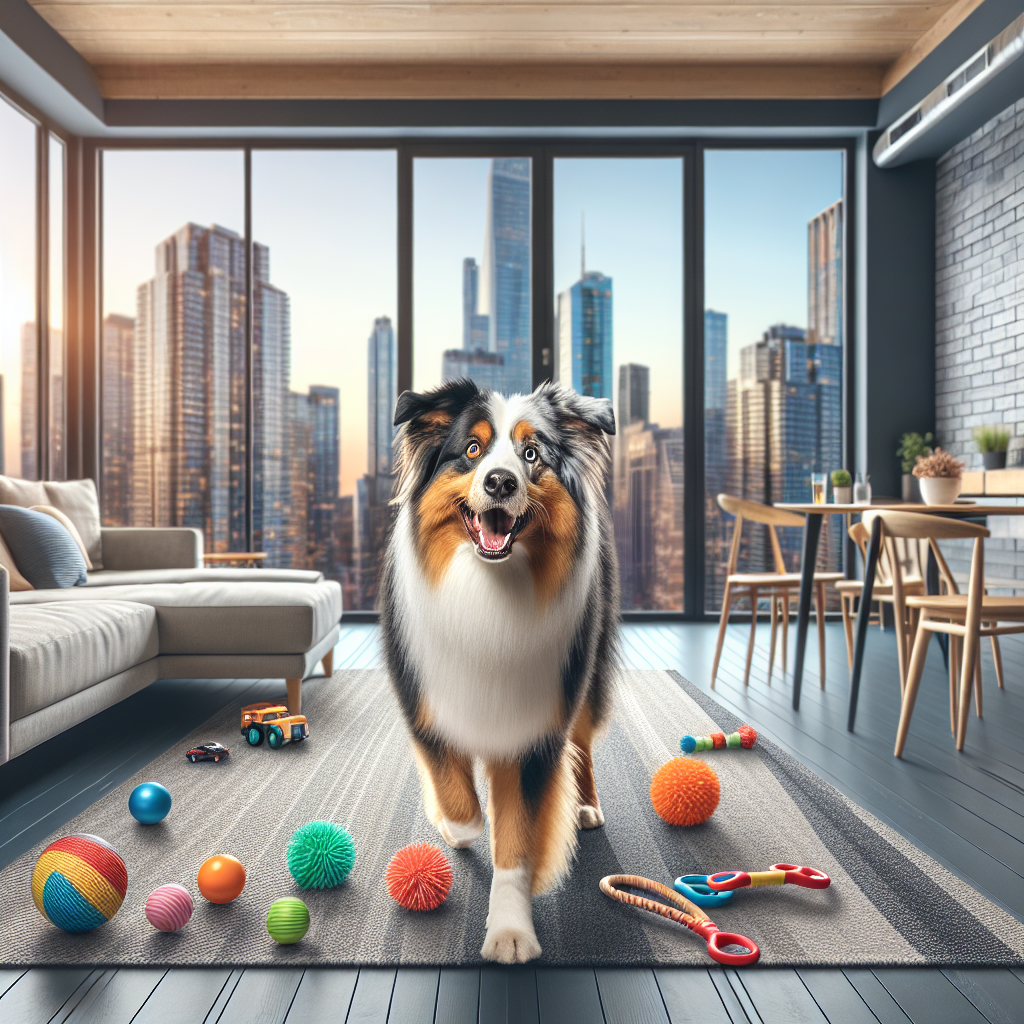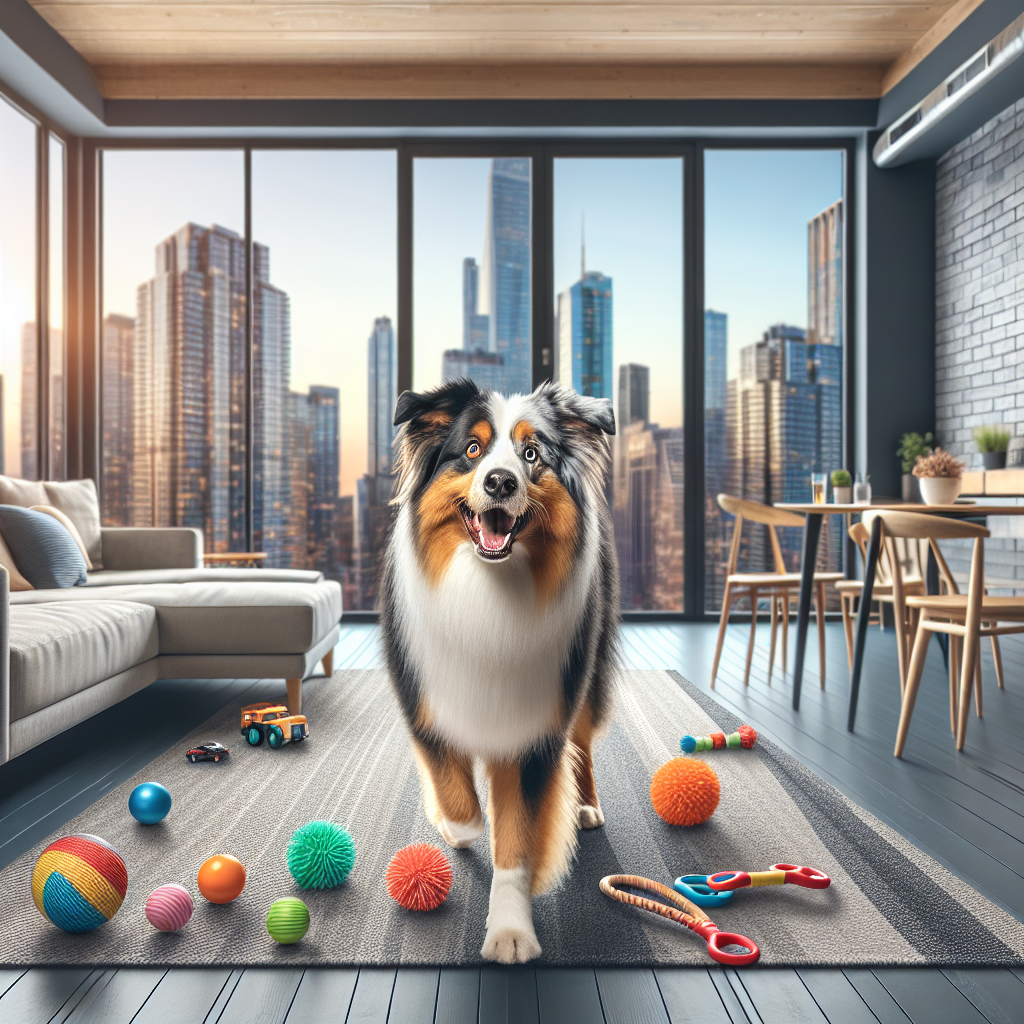If you’re considering bringing an Australian Shepherd into your life and wondering if they would be a good fit for apartment living, you’re in the right place. Australian Shepherds, known for their intelligence and high energy levels, are often associated with wide open spaces and herding livestock. However, you might be surprised to learn that with the right amount of exercise and mental stimulation, these beautiful dogs can thrive in an apartment setting too. In this article, we will explore the characteristics of Australian Shepherds and discuss some important factors to consider before bringing one home to your cozy apartment. So, grab a cuppa and let’s discover if an Australian Shepherd can be your perfect urban companion.

Physical Characteristics
Size
Australian Shepherds are medium-sized dogs, with males typically standing between 20 to 23 inches tall at the shoulder, and females slightly shorter at 18 to 21 inches. They usually weigh between 40 to 65 pounds, with males being on the heavier side. Their size makes them suitable for both apartments and houses, as long as they receive enough exercise.
Coat
Australian Shepherds have a thick double coat that is weather-resistant, providing insulation and protection from the elements. They have a medium-length outer coat that is straight to wavy and a dense undercoat. Their coat comes in a variety of colors, including black, blue merle, red, and red merle, with or without white and copper markings. While their coat is beautiful, it does require regular grooming to keep it in good condition and avoid matting.
Exercise Needs
Australian Shepherds are a highly active and energetic breed that requires daily exercise to keep them physically and mentally stimulated. They have a strong herding instinct and thrive in environments where they can engage in activities like agility training, obedience trials, and flyball. To keep an Australian Shepherd happy and content in an apartment, daily exercise is essential. This can include long walks, runs, or playtime in a securely fenced area.
Temperament
Intelligence
Australian Shepherds are highly intelligent dogs, ranking as one of the smartest dog breeds. They are quick learners and excel in training and obedience activities. Their intelligence also means they require mental stimulation to prevent boredom and destructive behavior. Puzzle toys, interactive games, and obedience training are great ways to keep their minds engaged.
Trainability
Due to their intelligence and eagerness to please, Australian Shepherds are highly trainable. They respond well to positive reinforcement training methods but can be sensitive to harsh training techniques. Consistency, patience, and positive reinforcement are key when training an Australian Shepherd. With the right approach, they can excel in obedience training and various dog sports.
Socialization
Proper socialization is crucial for Australian Shepherds to ensure they grow up to be well-rounded and friendly dogs. Early and ongoing socialization helps them develop good manners and positive interactions with people and other animals. Exposing them to various environments, sounds, and situations from a young age will help prevent fearfulness or aggression later in life.
Separation Anxiety
Australian Shepherds are known to be prone to separation anxiety, which is excessive distress when left alone. This breed thrives on human companionship and can become anxious or destructive if left alone for long periods. Apartment living may present challenges as they can become vocal or engage in destructive behaviors when feeling stressed or lonely. Providing mental stimulation, exercise, and gradually acclimating them to being alone can help mitigate separation anxiety.
Barking Tendency
Australian Shepherds have a moderate to high tendency to bark. They are alert and protective, making them vocal in the presence of strangers or unusual noises. In an apartment setting, excessive barking can disturb neighbors and potentially lead to conflicts. Early training and socialization can help curb their barking tendencies, but it requires consistent effort and positive reinforcement.
Apartment Compatibility
While Australian Shepherds are not typically thought of as apartment dogs due to their energy levels and need for exercise, they can adapt to apartment living if their exercise and mental stimulation needs are met. Living in an apartment may require extra effort to ensure they receive enough exercise and mental stimulation. Providing them with regular opportunities for physical activity and mental engagement is vital for their well-being in this environment.
Living Space Requirements
Indoor Space
Australian Shepherds are adaptable and can live in apartments as long as they have enough indoor space to move around comfortably. They are medium-sized dogs and require enough room to stretch, play, and relax. Apartment dwellers should ensure they have ample space for their Australian Shepherd, including a designated area for their bed or crate.
Outdoor Space
While Australian Shepherds can live in apartments, access to outdoor space is essential. They need regular exercise and mental stimulation, which can be achieved through daily walks, playtime in a dog park, or access to a securely fenced yard. Living close to parks or open spaces can provide additional opportunities for outdoor activities.
Noise Level
Australian Shepherds are known to be vocal dogs, so apartment dwellers should be prepared for some barking. However, excessive noise can be disruptive to neighbors and may lead to complaints. Proper training, mental stimulation, and addressing any underlying issues can help minimize excessive barking and noise.
Access to Exercise Areas
Living in an apartment requires planning and consideration of how to provide regular exercise opportunities for an Australian Shepherd. This can involve seeking out nearby parks, dog-friendly trails, or enclosed dog runs where the dog can safely exercise off-leash. Having convenient access to these areas can help ensure the dog receives the exercise it needs to stay happy and healthy.
Neighborhood Considerations
When considering an Australian Shepherd in an apartment, it’s essential to evaluate the neighborhood’s suitability. Look for pet-friendly communities with nearby amenities like parks, walking trails, and dog-friendly establishments. Additionally, checking local regulations regarding pet ownership, such as leash laws and breed-specific restrictions, can help ensure a smooth transition for the dog and owner.
Activity Levels
Daily Exercise
Australian Shepherds have high exercise needs and require at least 60 minutes of vigorous exercise each day. In an apartment setting, this can be achieved through long walks, jogging, or playing fetch in a secure area. Engaging in activities such as agility, obedience training, and interactive play can help meet their physical and mental exercise requirements.
Mental Stimulation
In addition to physical exercise, Australian Shepherds need mental stimulation to prevent boredom and destructive behaviors. Puzzle toys, interactive games, and obedience training provide mental challenges to keep them engaged and satisfied. Regular training sessions and opportunities to learn new tricks or commands can help keep their minds sharp and prevent behavioral problems.
Potential Challenges
Loneliness
Australian Shepherds thrive on human companionship and can become lonely or anxious when left alone for extended periods. This can be challenging in an apartment setting where owners may be away at work or have a busy schedule. To mitigate loneliness, owners can consider providing interactive toys, leaving the TV or radio on, or hiring a dog walker or pet sitter to provide companionship during the day.
Destructive Behavior
If Australian Shepherds don’t receive enough physical exercise and mental stimulation, they can engage in destructive behaviors. This may include chewing furniture, excessive barking, or digging. In an apartment, destructive behavior can be particularly problematic due to limited space and the potential for noise disturbance. Ensuring they receive adequate exercise, mental stimulation, and providing appropriate outlets for their energy can help prevent destructive behavior.
Proximity to Neighbors
Living in an apartment means sharing walls or floors with neighbors, so it’s crucial to consider how an Australian Shepherd’s behavior may affect others. Excessive barking, jumping, or running around may cause disturbances and lead to complaints. Consistent training, socialization, and addressing any behavioral issues can help ensure a harmonious living environment for both the dog and neighbors.
Access to Toilet Area
Living in an apartment requires careful planning when it comes to providing access to a toilet area for an Australian Shepherd. This may involve taking them for frequent bathroom breaks outside or utilizing designated indoor potty areas, such as puppy pads or artificial grass patches. Establishing a consistent routine and being prepared for more frequent bathroom breaks compared to living in a house is essential.
Training and Obedience
Basic Commands
Australian Shepherds are highly trainable and excel in obedience training. Teaching them basic commands such as sit, stay, come, and heel is important for their safety and the convenience of apartment living. Consistent training sessions using positive reinforcement methods can help ensure they respond reliably to these commands.
Behavioral Issues
Addressing any behavioral issues promptly is crucial for apartment living. Australian Shepherds can be prone to separation anxiety, excessive barking, and reactivity towards strangers or other animals. Seeking professional help, such as working with a certified dog trainer or behaviorist, can be beneficial in addressing and resolving any behavioral issues in a positive and effective manner.
Grooming Requirements
Brushing
Australian Shepherds have a dense double coat that requires regular brushing to prevent matting and keep their coat healthy. Weekly brushing is typically sufficient, but during shedding seasons, daily brushing may be necessary. Using a slicker brush or deshedding tool can help remove loose hair and prevent it from accumulating in the home.
Bathing
Australian Shepherds generally have an odorless coat and do not require frequent bathing unless they get dirty or develop a strong smell. Bathing them too frequently can strip the natural oils from their coat and lead to skin dryness or irritation. It’s best to use a mild dog shampoo and ensure thorough rinsing to prevent any residue from causing skin irritations.
Professional Grooming
While Australian Shepherds do not require professional grooming, some owners opt to have their dogs professionally groomed to maintain their appearance. This may involve trimming their coat, especially around the ears and paws, to keep them clean and free from matting. Professional groomers can also offer additional services such as nail trimming and ear cleaning.
Allergies and Shedding
Allergic Reactions
Australian Shepherds are not hypoallergenic dogs and may cause allergies in sensitive individuals. They have a double coat that sheds year-round, releasing dander into the environment. Regular grooming, including brushing and frequent vacuuming of the living space, can help reduce allergens and minimize allergic reactions.
Shedding Amount
Australian Shepherds are moderate to heavy shedders and require regular brushing to manage their shedding. They have a “blowing coat” seasonally, typically in the spring and fall when they shed their undercoat more heavily. During this time, daily brushing is often necessary to remove loose hair. Being prepared for shedding and incorporating regular grooming into the routine is essential for apartment living.
Family Suitability
Children
Australian Shepherds can make excellent family dogs and are generally good with children. They are known for their patience and gentle nature when properly socialized and trained. However, due to their herding instincts, they may try to nudge or chase smaller children, so supervision and teaching children how to interact appropriately with the dog are important.
Other Pets
Australian Shepherds can coexist with other pets, including cats, if introduced and socialized properly. Early socialization and gradual introductions are important to ensure they get along well with other animals. It’s essential to monitor their interactions and provide them with appropriate outlets for their energy to prevent any potential conflicts.
Breed Health
Common Health Issues
Like all dog breeds, Australian Shepherds are prone to certain health issues. Some common health problems seen in Australian Shepherds include hip dysplasia, elbow dysplasia, progressive retinal atrophy (PRA), and epilepsy. Regular veterinary check-ups, a healthy diet, and maintaining a proper exercise routine can help prevent or manage these conditions.
Exercise-Induced Health Risks
Australian Shepherds are an athletic breed that can be at risk for exercise-related injuries if they are not properly conditioned or suffer from overexertion. It’s important to gradually build up their exercise routine, avoid excessive exercise in extreme weather conditions, and provide adequate rest and recovery time.
Regular Veterinary Care
To ensure the overall health and well-being of an Australian Shepherd, regular veterinary care is crucial. This includes routine vaccinations, parasite prevention, dental care, and annual wellness exams. Regular check-ups allow for early detection and treatment of any potential health issues, keeping the dog happy and healthy for years to come.
In conclusion, while Australian Shepherds may not be the first breed that comes to mind when thinking of apartment dogs, they can adapt to apartment living if their exercise, mental stimulation, and socialization needs are met. They require a dedicated owner who can provide them with ample exercise and mental enrichment, along with proper training and socialization. Australian Shepherds thrive in environments that offer access to outdoor spaces and nearby amenities that cater to their active and intelligent nature. With the right care, training, and environment, Australian Shepherds can thrive in an apartment setting and make loving and loyal companions for their owners.

